All profits to

Archive Home Page
Previous Exhibition Following Exhibition
St. Margaret's Hall, Coniston Road, Hatherley, Cheltenham, GL51 3NU
All profits to |  |
Descriptions are based on material supplied by the layout owners
Barton Hill Until recently when travelling either North or East from Bristol Temple Meads you could view from the train window the English, Welsh and Scottish Railways deport of Barton Hill. This is now hidden by more recent buildings, but just a few years ago it was a Rail Express Services Depot hosting a range of red liveried postal rolling stock. This model is intended to give an impression of that depot. Baseboard construction is of plywood, Peco track is laid on a cork base and electric point motors are a mixture of Peco and Seep. Railfreight wagons are fitted with Peco uncouplers to enable "hands off" operation by means of strategically placed electro magnets. Some modelers license is used so that I can run what I like to enable me to play trains. |   | |
  |
Bishopsmead is a busy terminus located 'somewhere' on the Western/Central division of the LMS, set in the mid 1930s. The actual location presumes the area to be a popular leisure destination, which necessitates many passenger trains including the odd excursion from other companies. Although Bishopsmead is built as a terminus, it is not the end of the branch line from the junction with the LMS network (at Castlebury), the line progresses on to the terminus at Smallcombe. However, the connection to Smallcombe is via a trailing connection in the down direction only, located beyond the tunnel. This necessitates all Smallcombe trains reversing at Bishopsmead, which in addition to handling its own normal traffic, also handles the local, connecting and through traffic to and from Smallcombe. The layout portrays the station of Bishopsmead and the line as far as the tunnel. A connection to the local industrial area at Bishopsmead is modelled (but not the area itself). The junction for Smallcombe and Castlebury are represented by the 'Fiddle Yards', as is Smallcombe itself. Although the locations are fictitious, an operating sequence has been developed and is run which is both plausible, intense and (we hope!) more or less correct. The stock on the layout is a mixture of predominantly kit, modified kit or scratch built items together with the odd extensively modified proprietary items. Stock is generally is in both the early and later pre-war livery styles. The buildings are a mixture of kit/modified kit or scratch built, and the scenery is constructed using all the usual Woodland Scenics materials and the like. | |
Cumberland Mineral Railway The Cumberland Mineral Railway follows a very popular and practical format for narrow-gauge layouts; it is built to 7mm scale and uses 00 gauge track. Although it is fully operable and scenically well developed, there are still things to be done to it before it can be called truly complete. I have avoided the temptation to include models of actual prototypes, although similarities will be seen to locomotives and stock which appeared in manufacturers' catalogues over the years and might have realistically appeared on a small railway which did not have the resources to design and build things for itself. Imagine this small railway to be situated in a quiet area of the northern Lake District, transporting slate, coppiced timber and bobbins from the mill, a limited amount of general merchandise and passengers from Millbeck in Bannerdale to a junction with the mainline at Greystoke. Bannerdale really exists but you will struggle to find it on a map. Perhaps the flooding of the valley to create Bannermere Reservoir, a few years after the period the model represents, is partly responsible for that. | 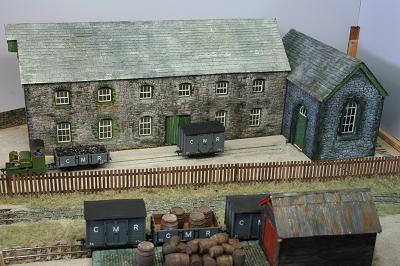 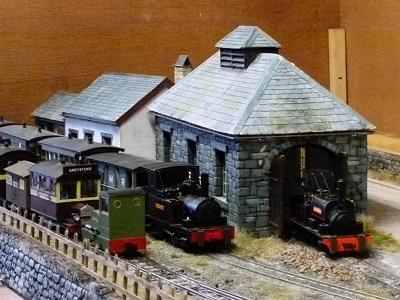 | |
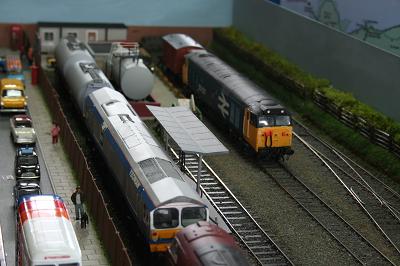 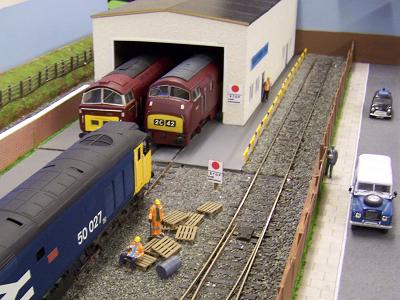 |
Figges Marsh TMD is a small '0' gauge layout of a Traction Motive Depot operatimg locos from the Mid 60's to Mid 80's. This era was chosen s we could run maroon Warships, Westerns, blue locomotives plus large logo to the rirst class 59. The buildings are kit or scratch-buil and the layout operates totally on DCC. | |
Gas Lane Gas Lane is a follow up to my previous layout Condicote, which featured in Hornby magazine Issue 7. it came about after my club's exhibition manager came looking for layouts and I offered a new layout for the annual show. I then puzzled as to what to build. The result is this compact gas works setting which uses a baseboard 4ft 8 1/2ins x 1ft 4in to portray goods operation in an industrial setting. Historically resources for gas works are scarce, but a visit to Fakenham gas works in Norfolk, which is England's only complete, although non-operational gas works, provided all the information I needed to get started. I've always enjoyed scenic modelling and much time and effort has been invested in adding details to the layout including people, scenic items and especially within the garden of the manager's house. In operation I have a wide range of rolling stock to choose from and due to its nature Gas Lane can operate in a number of periods and regions by changing the locomotives and rolling stock over. As a minimum space layout Gas Lane is very entertaining to operate. | 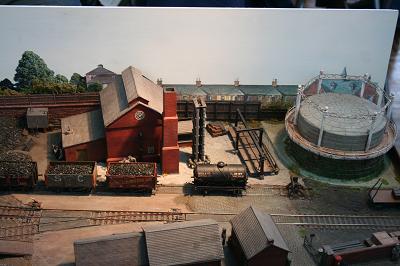 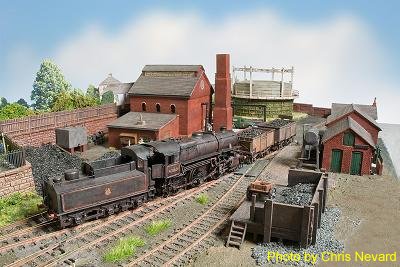 | |
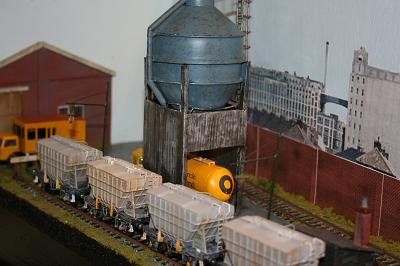 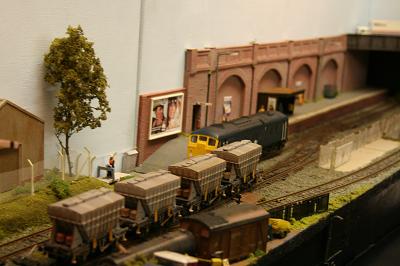 |
The layout is so named as the baseboards started life as 2 forklift pallets and is an imaginary urban branch line Station set around 1977. The layout is not set in any particular city and changes based around the stock and vehicles on display but the inspiration from the layout came from childhood memories of travelling on the Severn Beach line in Bristol. The station area is loosely based around Clifton Down; cement terminal is similar to that at Lawrence Hill, and the fuel oil siding around Shirehampton. The small station still sees a regular passenger service usually a 1 or 2-car suburban DMU, as there are a number of large factories in the Pallet Lane area. The passenger facilities are rudimentary, just a small wooden shelter on the platform. The layout in the format exhibited today is 12'2" long by 17" and is DC controlled, trackwork being Peco Sreamline code 100. All stock is modified Ready To Run and kit-built weathered and detailed. | |
Polpendra Polpendra is a small terminus station and the end of a Y on a branch line somewhere West of Dartmoor, Devon. One direction runs to the mainline and the other on to a small china clay works hence the occasional visit of clay trains which run in, run around and run out again. The station also has operating rights for the occasional Southern region service as well so the variation to be seen is far in excess of any station in real life of Polpendra's size. The idea behind the layout was to develop a taste of a West country branch line as far as possible, an aim I hope people think I have achieved. | 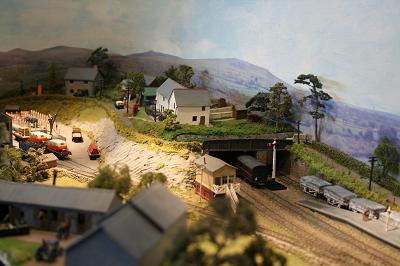  | |
  |
Set in the coal-mining region of the Appalachians the layout represents scenes from the last decade or so on what is now the Norfolk Southern (NS) railroad. The NS was the result of a merger between the Norfolk and Western and Southern railroads. The Southern was noted for the efficiency of its operations and the N&W for its coal hauling. The mine on the upper level is typical of an older type of unit during the last days of its life loading bottom discharge hopper cars bound for the few industries that still need this type of unloading. The cars are taken from the mine and eventually reach an interchange with the main tracks on the lower level. On the lower level can be seen the modern unit coal trains which need rotary tipplers to empty them as they do not have doors on the bottom. These cars run in long block trains from the mines to the power stations or other big users. Others trains to be seen include wood chips in very large gondolas,roadrailers, manifests (mixed), intermodaT and MoW (engineers) trains. Red River featured in the January and February 2005 editions of 'Continental Modeller' and has been shown at Banbury (NScaleUK), Lydney, Ross (NMRA), Chippenham (Trainwest), Caine, Andover (Modelex 2005), Rhondda (S. Wales Model Show), Cheltenham, Abingdon, Alton, TOlworth, High Wycombe, Warley (NEC), Rail-Ex Southwest (Taunton), Derby and Truro (Three Spires Railex). | |
Teigl Tramway The Teigl Tramway is a narrow gauge layout in 0-14 (7mm scale with a track gauge of 14mm). The model depicts a Welsh slate carrying narrow gauge railway. There is a junction on the 'main line' from which a tramway branch climbs steeply, partly following the road before entering a ledge on the rocky hillside. Passing a slate quarry it disappears into a tunnel to serve the higher part of the valley. The main line continues across a river and passes a slate works and a woollen mill before entering the fiddle yard. | 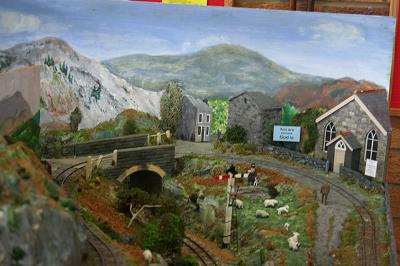  | |
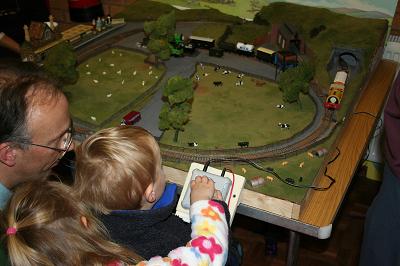 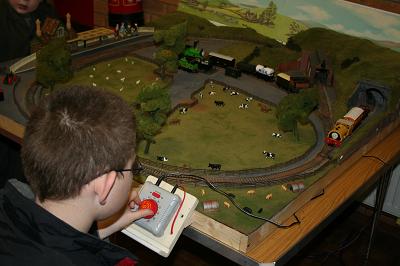 |
We would like to thank Trevor Hallam for looking after the Thomas Layout for many years at our exhibitions and also for refurbishing it at his expense. Unfortunately because of ill health Trevor is no longer able to continue so it was decided to offer Thomas free of charge to Hucclecote Railway Modellers on condition they bring it to all of our future exhibitions. This is the model railway where Children can become Engine Drivers on the Island of Sodor and has of course been inspired by the Reverend Audrey books. Our Thomas and Friends layout has been built for ten years now and in that time we hope it has encouraged many new railway enthusiasts to build a train set of their own. Originally it was intended as a space filler at shows so needed to be small, easy to transport and have a simple track plan, easy for small children to operate. After its first appearance it was clear this model railway would have to be included at all our exhibitions. It incorporates a tunnel, station, level crossing together with locomotive and goods facilities. Train drivers should look out for many of the popular characters; Henry, Percy, Toby, Cranky, the Troublesome Trucks, not forgetting the Sir Topham Hatt better known as the Fat Controller. The famous anthropomorphised rolling stock is mostly from the Thomas range and we are sure most of the adults and all the kids will love it. Happy Driving, but please observe the track speed limits. | |
Wheal Elizabeth Wheal Elizabeth is a fictional representation of the Cornish china clay industry and is largely inspired by Great Wheal Prosper at Carbis Wharf off the Newquay Branch. This clay works did not close until 1989 and was virtually unchanged from the 1950's. The layout chronicles the various types of engines and rolling stock typically seen on Cornish clay trains in the period in between, so don't be surprised to see steam engines in the morning and diesels in the afternoon. There are only two rules: every engine you see will have been photographed on a clay train somewhere and rolling stock will be appropriate to the engine hauling it. | 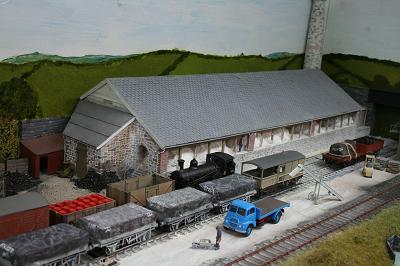 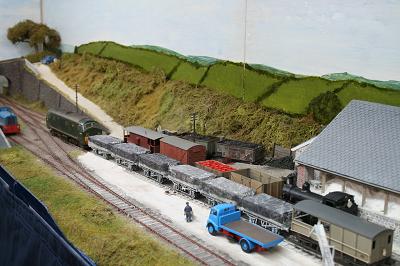 | |
| Displays | ||
Model Bus Federation WEBSITE | NARTM (road transport) WEBSITE | |
Travel 2000 Ltd | The Grumman Story WEBSITE | |
| Modelling Demonstrations | ||
| Andi Dell | Harvey Faulkner-Aston | |
| Mark Begley | Steve Harrod | |
| Trade | ||
| Cheltenham Model Centre WEBSITE | Iron Horse DVDs | |
| Penduke Models WEBSITE | Railway Resprays, Jason Hannant | |
| RCSW (Pre-owned) Models, Clive Reid | Rly books, timetables, photos, Stewart Blencowe WEBSITE | |
| Robbie's Rolling Stock WEBSITE | ||